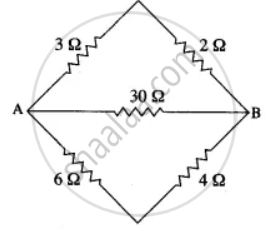Advertisements
Advertisements
प्रश्न
उत्तर
Ohm's law relates the current in a conductor to the potential difference across its ends.
According to Ohm's law, the current flowing in a conductor is directly proportional to the potential difference across its ends provided the physical conditions and temperature of conductor remains constant.
APPEARS IN
संबंधित प्रश्न
What Makes an Electric Current Flow in a Wire?
What happens to the other bulbs in a parallel circuit if one bulb blows off?
An electric bulb is rated as 10 W, 220 V. How many of these bulbs can be connected in parallel across the two wires of 220 V supply line if the maximum current which can be drawn is 5 A?
State two differences between the e.m.f and terminal voltage of a cell.
Calculate the equivalent resistance between A and B in the adjacent diagram.

An electric bulb is rated '100 W, 250 V'. How much current will the bulb draw if connected to a 250 V supply?
A bulb of 40 W is used for 12.5 h each day for 30 days. Calculate the electrical energy consumed.
